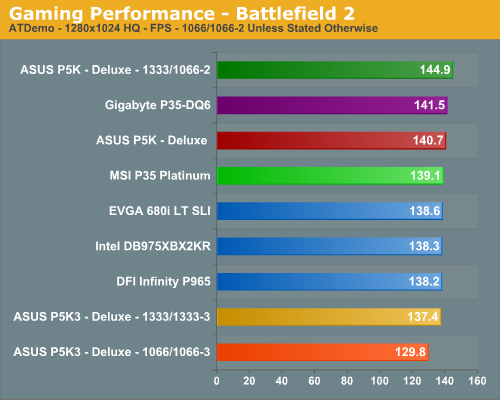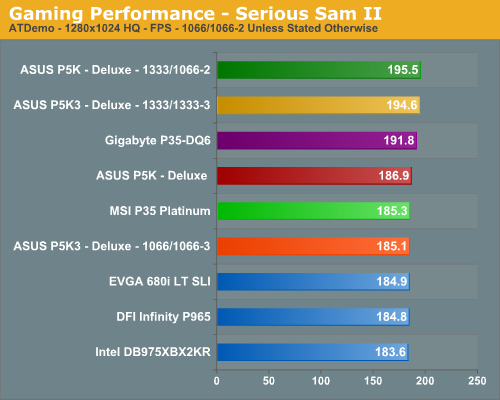Intel P35: Intel's Mainstream Chipset Grows Up
by Gary Key & Wesley Fink on May 21, 2007 3:45 PM EST- Posted in
- CPUs
Gaming Performance
As usual, gaming performance was tested with a variety of current games. We ran benchmarks with our standard 1280x1024 resolution with all games set to High Quality mode. Given the number of users that run 19" LCDs these days, 1280x1024 represents one of the most commonly used resolutions. We will provide final CrossFire numbers in our P35 roundup.Battlefield 2
This benchmark is performed using DICE's built-in demo playback functionality with additional capture capabilities designed in house. When using the built-in demo playback features of BF2, frames rendered during the loading screen are counted in the benchmark. In order to get a real idea of performance, we use the instantaneous frame time and frames per second data generated from our benchmark run. We discard the data collected during the loading screen and calculate a result that represents actual game play. While DICE maintains that results over 100fps aren't always reliable, our methods have allowed us to get useful data from high performing systems.
During the benchmark, the camera switches between players and vehicles in order to capture the most action possible. There is a significant amount of smoke, explosions, and vehicle usage as this a very GPU intensive Battlefield 2 benchmark. We run Battlefield 2 using the highest quality graphics settings available in the video settings. The game itself is best experienced with average in-game frame rates of 40 and up.

Serious Sam 2
This benchmark is performed using Croteam's built-in demo capability in the Serious Sam II engine. We utilize the included Branchester Demo and capture the playback results using the Ctrl-~ function. The benchmark features a large number of combatants, explosions, and general mayhem. The benchmark is primarily GPU sensitive with the actual percentage of GPU/CPU/Audio activity being displayed during the benchmark run. We typically find this game is very playable at average in-game rates of 60 and above. We maximize all settings except antialiasing and anisotropic filtering within the general and advanced video settings.

F.E.A.R.
F.E.A.R. uses a built-in performance test that generates graphical test scenes based upon the actual game engine. This test consists of a couple of different action sequences, a stressful water flyby, and heavy use of shadows while traveling through hallways. F.E.A.R. is a very graphics intensive game and we switch all settings to maximum for both the system and GPU. During our testing of F.E.A.R., we noted that the "soft shadows" don't really look soft and the performance hit is drastic, so we disable this setting. An average frame rate for F.E.A.R. can dip drastically during game play and that is not good for a first person shooter but the game is still playable around 35fps although we prefer a solid 45fps.

Gaming Summary
We see the DDR3 setups struggling in the Battlefield 2 tests in a game that is both CPU and memory sensitive. The high latencies of our DDR3 systems are taking their toll in this game. Fortunately, in the CPU/GPU bandwidth hungry F.E.A.R., the DDR3 platforms have a slight advantage. Our Serious Sam 2 benchmark is CPU/memory sensitive and the increased bandwidth offered by the 1333FSB boards allows them to take the lead.










58 Comments
View All Comments
Wesley Fink - Monday, May 21, 2007 - link
Early boards will be expensive, just like always. The prices will likely drop to the same levels as current P965 boards they replace, with a broad range for P35 boards from basic to "Asus Commando" level gaming boards. It is too early to be discouraged.Comdrpopnfresh - Tuesday, May 22, 2007 - link
I'm willing to bet we'll see them replacing the older boards quickly too. If intel and other manufacturers really want DDR3 to go through, you'll see DDR2 boards disappearing quickly. Its like what happened to s939. Basically the same chips were used for AM2, but the boards and chips quickly dried up and disappeared. The same can be said or PCI-e. In the beginning there wasn't much of a real world benefit, just the theoretical bandwidth increase. Because developments in AGP ceased, we might never know if the switch was necessary.Comdrpopnfresh - Monday, May 21, 2007 - link
If something other than NAND flash could be used, it would be very interesting to see a pci-e 1x board that can house DDR2 memory for use in turbo memory. That way, when people upgrade their ~35 boards to DDR3 when performance and price changes, the DDR2 can be used further. This would make a lot of sense too, because unlike Gigabyte's i-RAM device and logical ramdrives, the high speed, low latency properties of RAM could be used for turbo memory as a way around the 8gb limit of RAM on these cards. And since they are not used for storage, merely access, no redundancy on power supply is needed as with the i-RAM. Someone should start development on this...Comdrpopnfresh - Monday, May 21, 2007 - link
Why would the TDP on the P35 higher if it has no integrated video? Will third-party manufactures implement their own SLI into the P35 given that the reference model only had on x16 pci-e slot? Also, when can we expect to see pci-e2 and more than 4 dimm slots on intel mobos?yacoub - Monday, May 21, 2007 - link
Including a jumper to change the strap setting for the fsb is a nice feature on the MSi board. A little disappointed in the memory comparison test that that board had the lowest bandwidth and most latency. Is that something BIOS updates can improve or is that generally hardware (i.e. board design related)?Gary Key - Monday, May 21, 2007 - link
It is all BIOS tuning in regards to the MSI board. Our first results with the board had the memory performance being equal to the 945P boards. Two BIOS releases later and the improvements have been remarkable. I think MSI is about two BIOS spins behind ASUS and Gigabyte now. Gigabyte finally caught up but ASUS still has the better feature set and options in my opinion.michal1980 - Monday, May 21, 2007 - link
hardocp, seems to take a 180 different outlook on these boards. so werid.skaterdude - Monday, May 21, 2007 - link
What's so weird? Kyle is an extension of AMD's marketing department. He has not cared for Intel in a very long time, at least since he was caught cheating on some Intel benchmarks and was hung out to dry for it. Personally, it is alright to have a favorite company to root for but to do so in such an open and bias way is wrong if you are not running a company specific website. I would not have an issue at all if it was called HardAMD, at least you know what you are viewing is not tainted by free trips, booze, products, and general hostility against a company.
Back on subject....The P35 is a nice upgrade and it may not set the world on fire but it appears Intel listened and improved on a chipset they could have let ride for a lot longer. DDR3 will be interesting and at least the kinks will be worked out by the time X38 and the new processors get here. If I had not already bought a 965 board then P35 would have been the one. I am still miffed about not having a native IDE port as JMicron just plain sucks most of the time.
strikeback03 - Tuesday, May 22, 2007 - link
the P35 does not have native IDE either, and why use an IDE drive anyway?Spoelie - Monday, May 21, 2007 - link
ahum, AMD biased? After reading some of their recent gpu reviews, I thought it was the other way around... Check yourselfanyway, not a worthy upgrade, but a worthy new board. Which is what you could reasonably expect.